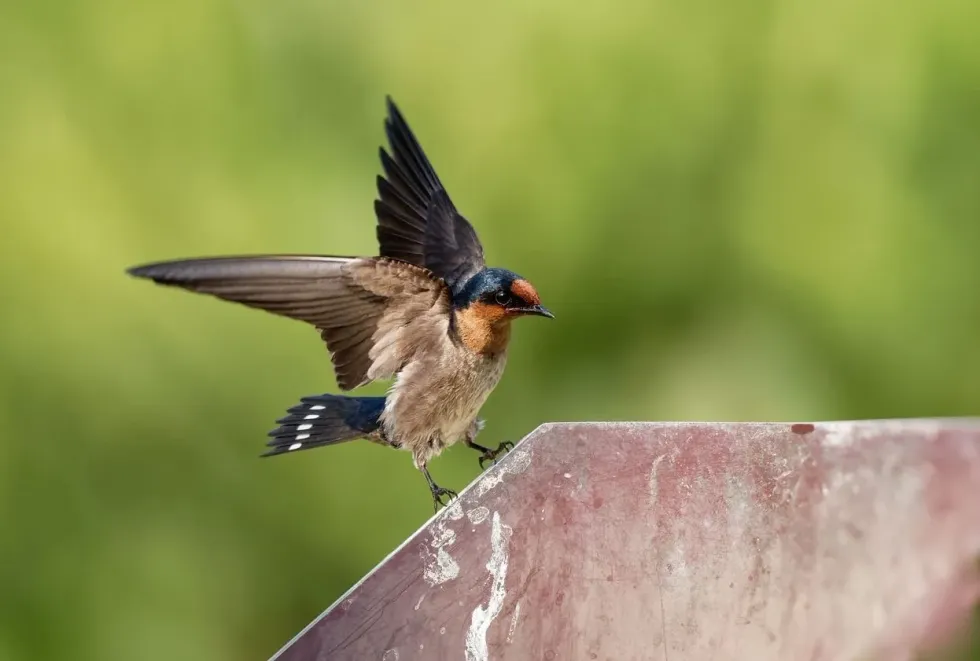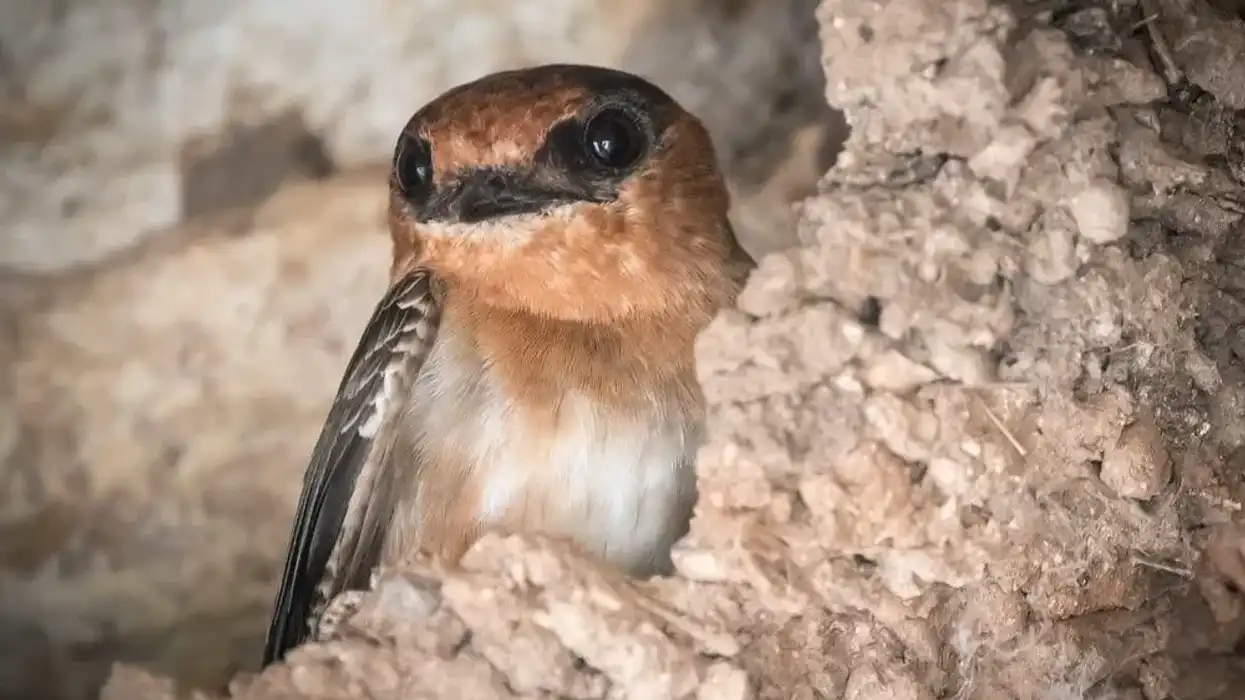Pacific swallows (Hirundo tahitica) are members of the swallow family and are songbirds of nature. The maximum range of the bird is found in tropical southern Asia as well as islands in the South Pacific.
The species is a resident apart from a few seasonal movements. The birds are very small in size and often confused with other swallow species such as the barn swallow and the welcome swallow.
The bird is often seen perching atop telephone lines in cities while looking for places like a cliff ledge for building its nest. They are aerial insectivores and very adept at flying close to the grounds in search of insects like flies to eat.
If you read this article and like it, you can consider reading similar facts about northern parulas and cockatoos.
Pacific Swallow Interesting Facts
What type of animal is a Pacific swallow?
The Pacific swallow (Hirundo tahitica) is a bird species that belongs to the family of Hirundinidae.
What class of animal does a Pacific swallow belong to?
Like all other species of birds, the Pacific Swallow (Hirundo tahitica) is also a member of the Aves class and belongs to the kingdom Animalia.
How many Pacific swallows are there in the world?
The exact population distribution of the birds in the world is not known. However, being a Least Concern species, it can be assumed that the bird is plenty in numbers all across the world.
Where does a Pacific swallow live?
South Pacific islands are the place where you might see the birds most commonly. The range is also distributed in tropical southern Asia such as in the countries of Japan, India, Singapore, and Thailand.
Some more nations to spot the swallows are Fiji, Papua New Guinea, and Laos. Subspecies of these swallows are distributed all across the southern Pacific islands.
What is a Pacific swallow's habitat?
It is common to associate the Pacific swallow (Hirundo tahitica) with the coast but recent trends show that the bird can be spotted in forested uplands as well. The nests of the bird can be found on several man-made structures such as bridges, tunnels, and buildings.
The ledge of a cliff is a preferred place for the building of nests by the Pacific Swallows. You can see the member of the swallow family more in urban areas than in the countryside. Cities and towns are favored habitats for the swallows.
You might even sight some of them above lakes and fields. They perch on telephone lines in the cities alongside other swallow subspecies.
Who do Pacific swallows live with?
Swallows generally nest in colonies. The size of the colony can range from a single pair to a number of pairs. Large flocks of swallows are also seen living together in one place.
How long does a Pacific swallow live?
The average lifespan of the Pacific swallow (Hirundo tahitica) is about four years.
How do they reproduce?
Not much is known about the breeding of the Pacific swallows. We know they line their nest with soft material. The size of the clutch is quite small. The clutch consists of two to three eggs.
What is their conservation status?
According to reports of the International Union for Conservation of Nature Red List of Threatened Species, the Pacific swallow (Hirundo tahitica) is a species of Least Concern with an unknown population trend. The distribution of the species is widespread so there is no need for any conservation activities at the moment.
Pacific Swallow Fun Facts
What do Pacific swallows look like?

Pacific swallows (Hirundo tahitica) are perching birds, or Passeriformes. The species has a red face and the same colored throat. The forehead is rufous in color. The underparts are dusky in nature.
The identification marks of the species are its bluish-black back and its brown tail and wings. It has a grayish buff below. It is distinguished from the barn swallow by its less forked tail which is shorter compared to the previous swallow.
How cute are they?
Pacific swallows can be considered cute birds. The small size of the species coupled with their colorful feathers gives attributes of cuteness to these birds. While it remains airborne, the swallow is a delight to watch.
How do they communicate?
Swallows are known as songbirds as they use a number of calls or songs when they want to communicate with each other. These calls have different meanings. Some denote mating calls and express excitement while another is for raising alarm when a threat is perceived.
How big is a Pacific swallow?
Swallows are generally small birds. The Pacific swallow (Hirundo tahitica) is no exception. The maximum length of the species varies between 5.12-5.51 in (13-14 cm). Compared to this, the short-eared owl is thrice the size with their maximum size being 16.7 in (42 cm).
How fast can a Pacific swallow fly?
Pacific swallows are known for their flight and it has been observed that they are fast flyers. They feed on insects while airborne.
How much does a Pacific swallow weigh?
Although there is no available data to determine the weight of the Pacific swallows, it can be assumed that similar to other swallows, they are also lightweight birds. The small size further confirms that their weight is minuscule.
What are the male and female names of the species?
The male and female Pacific swallows have no distinct names for them and the identification process is quite difficult.
What would you call a baby Pacific swallow?
Baby Pacific swallows are known as chicks.
What do they eat?
Pacific swallows are aerial insectivores and behave in a similar way to other insectivores such as swifts. If you see a Pacific swallow flying, chances are that it is looking for insects like flies to eat while being airborne.
They will often fly low in order to catch tiny flying insects. The swallows themselves are in danger of predatory birds like hawks and falcons.
Are they dangerous?
The word 'danger' is totally unrelated to the Pacific swallow (Hirundo tahitica). They are small birds in search of free breeding spaces among man-made structures. They are often found living closely with humans.
Would they make a good pet?
Although the neat cup-shaped nest of the Pacific swallow is found in spaces closely related to human beings, they are not at all suitable to be used as pets. It is a free bird species that fly wherever it wishes to.
Did you know...
Swallows are unrelated to swifts although several people think they are. They are not closely related in any way.
Swallows are found all over the world except in Antarctica.
The meaning of the word swallow is throat in Middle English. From here the name of the bird has originated.
Generally, swallows are harmless birds but if you get too close to their nests, you might be attacked by them. This is especially true about barn swallows.
Purple martens are the largest species of swallows in the world.
Difference between a Pacific Swallow and Barn Swallow?
People are often confused when it comes to Pacific swallow vs barn swallow. The Pacific swallow has a less forked tail that is also shorter. The barn swallow has a blue breast band that is lacking in the Pacific swallow.
What is unique about Pacific Swallows?
A unique feature of the Pacific swallow is its neat cup-shaped nest. It is made from mud pellets on vertical surfaces. The pellets are collected in the bird’s beak. While flying, the bird folds its wings back that is unique among other species.
Here at Kidadl, we have carefully created lots of interesting family-friendly animal facts for everyone to discover! Learn more about some other birds from our common swift facts and Blackpoll warbler facts pages.
You can even occupy yourself at home by coloring in one of our free printable Pacific swallow coloring pages.









